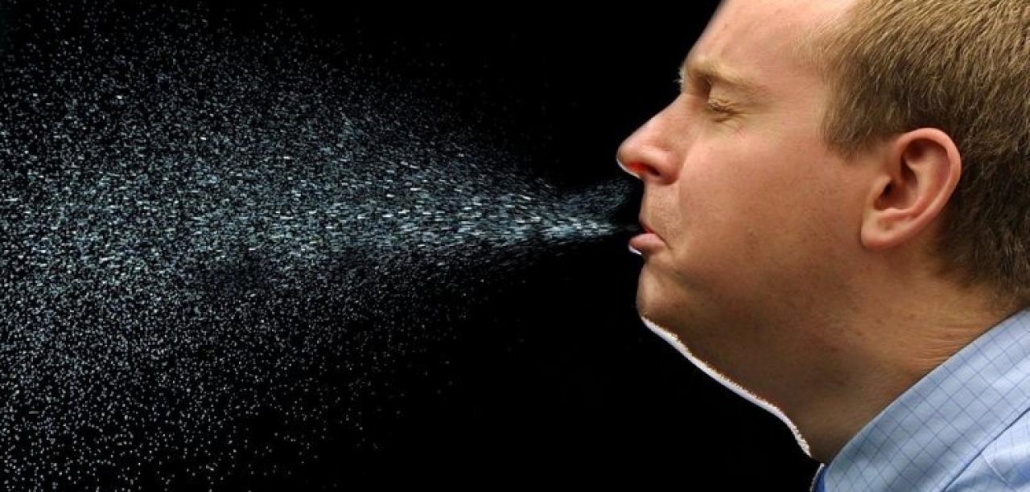Every year, millions of people catch the flu resulting in 31.4 million doctor visits costing billions in lost productivity and healthcare expenses. A 2016 study pegged productivity losses at a $5.8 billion hit to American business. With the deadly Covid-19 pandemic, the blow to small, medium and large businesses and taxpayers is staggering. Worse yet, tens of thousands of people die from exposure to the latest strain of antibiotic-resistant germs and viruses like influenza, MRSA, Norovirus, SARS and now the deadly Coronavirus. So, how can we mitigate the spread of viruses and other pathogens as well as prevent the next pandemic?

By now, most people on the planet are aware that the Sars-CoV-2 virus causing the Covid-19 pandemic can be transmitted via droplets from sneezing, coughing or direct transfer. But various peer-reviewed studies and lab reports also show that it can live on common surfaces for hours and days. Thus, it’s important to keep those surfaces clean. But, that’s not easy. For decades, the main defense against germs and viruses has been spraying and pouring billions of gallons of harsh and toxic cleaning agents over everyday surfaces in hopes of keeping them “clean”. Sadly, all this effort is temporary. The next cough or sneeze or touch can put those germs back. Testing proves those surfaces are just as dirty soon after, requiring even more chemicals and protective measures. Our global reliance on antibiotics and billion dollar drugs is proof that cleaning (or cleaning methods) are largely ineffective. Worse yet, all those cleaning chemicals get into our food, our pets and the environment causing cancer and all sorts of unnecessary health risks and damage. Which requires even more drugs! What if there was a better way to make all those surfaces somehow just stay clean.
With new nano-technology, that day may be here. Check out these two novel approaches:
Anti-microbial Materials
Microban is a company that sells anti-microbial compounds to other manufacturers so they can be “baked into” manufactured products like food storage, yoga mats and hospital bed rails. The anti-microbial products then release trace amounts of silver or other deadly agents to fight off or disable the attacking pathogen. This mitigates or reduces the need for constant cleaning to fend off the germs typical to those applications. The downside is the anti-microbials that are baked in don’t necessarily protect against a broad spectrum or the latest viral strain. The other downside is all the other surfaces that are NOT protected. Do you know which, if any, building materials in your home or office have anti-microbial properties? Probably not. The process of saturating Microban’s proprietary chemicals into product manufacturing can be very expensive. With consumers and supply chains always looking for lower costs, it should be pretty logical that most consumer goods and building materials are NOT anti-microbial. And without testing, how do you really know if all your surfaces are protected anyway? That’s where PermaClean shines.
PermaClean
PermaClean is similar to Microban except they take a more elegant approach. PermaClean’s food-safe, nano-coatings are applied to the surface of common materials causing them to be highly water and oil repellent. Here’s where it gets interesting. In the molecular world, size matters. Think of these nano-coatings as a super-fine mesh of molecules bonding together so small that they easily block oil and water molecules. Since bacteria and viruses are 100 – 1,000 times larger than water molecules, they are easily blocked as well. That means nasty stuff like salmonella, MRSA and SARS viruses (e.g. coronavirus) won’t stick to those surfaces anymore! The submicroscopic barrier gives that material new super powers to repel water, oils, bacteria, germs, mold, mildew and of course, viruses. PermaClean’s nano-coatings work on virtually any substrate (material), including: plastic, metals, glass, textiles, stone, concrete and others.
By making those everyday surfaces super hydrophobic, oleophobic and resistant to pathogens, the need for frequent chemical cleaning is greatly reduced. Everyday surfaces stay cleaner longer and become significantly more resistant to soiling, mold, mildew, bacteria and other bad stuff. Based on our testing, simple and frequent wipe downs are more effective. In fact, water may even be the only “cleaning agent” needed. That’s a game-changer in the environmental sustainability world. For health care, that could be a big, big edge against pandemics. Perhaps the best part is the cost savings. Longer lasting clean means better health safety, lower health care costs, less time cleaning, reduced environmental impact and lower overall costs to operate your business or home.
Let’s see how this can impact the following industries immediately.
Food Service.
Salmonella seems to be omnipresent in our lives since it is naturally existing in all poultry like chicken, eggs and other everyday foods. Undercooked poultry will make you very sick. But so will unwittingly spreading of those germs during food prep. Check out this video (below) to see what happens when a common food prep surface, like stainless steel, is PermaCleaned. Spolier alert, the results are shocking.
PermaClean coatings form a tight barrier so bacteria and other pathogens can be washed away with water.
Can you think of any fast casual or quick serve restaurant brands whose stock price would have greatly benefited be being PermaCleaned?
Schools and Public Spaces.

Social distancing and constant hand washing are helpful, but pretty impractical and unreliable. Ask any teacher or parent. Kids are little “germ factories”. Why? First, little kids are just developing sanitary practices like proper hand washing and covering up when sneezing. Heck, I’d say most adults are still “learning”. Anyway, since babies and kids are also learning by tactile feel, they tend to touch and even taste all kinds of gross things. Then, those little darlings inadvertently pass those germs along to everyone else before any symptoms even show up. Homeless people have similar issues. They are constantly exposed to the elements and live in highly unsanitary conditions with sparse public facilities available for personal hygiene. Those facilities require even more rigorous cleaning that is costly and rarely accomplished. Since humans are so contagious before symptoms are revealed, that’s precisely why the flu and other deadly viruses like the Coronavirus are so scary. They are transmitted by sneezing and coughing which can turn into a global emergency overnight. Protecting employees and the public takes diligence and efficient means. Without that, people die and entire economies can lay in ruins, fast. Look at the Covid-19 pandemic. Can you think of any teachers, school districts, colleges or civic spaces that would benefit by being PermaCleaned?
Airplanes, Theaters, churches and other gathering places.

Imagine sitting down in a comfy chair, ready to enjoy the music or flight, then you realize there’s a big patch of goo on the back of your chair. Hopefully that doesn’t happen, but what if someone before you sneezed into their hand and touched your seat back, leaving a nice petri dish of germs or bacteria waiting for you to sit on or lean against. If those seats were made of Microban-impregnated materials or were coated by PermaClean technicians you’d be better protected from undue exposure. If it’s your business, your guests would have peace of mind so you can focus on your core business instead of wondering if your venue would be the epicenter of the next pandemic. Can you think of any airlines whose flight attendants would be so relieved to have seats and interiors PermaCleaned?
Office spaces.

In business, productivity is everything. In fact, productivity is a bell weather of the American economy. When your business depends on people to get things done, which is pretty much every business, you need them healthy. So, if staff and visitors are worried about cleanliness or out sick, they will be a lot less productive. PermaCleaning common touch areas will help keep everyone safer and you guessed it, more productive. Can you think of any property management companies that would attract more customers if all their properties were PermaCleaned?
BACTERIA
Methicillin-resistant Staphylococcus aureus (MRSA)
Easily transmitted in a hospital environment and resistant to most staphylococcus antibiotics including oxacillin, penicillin, amoxicillin, and methicillin, MRSA has only a few expensive treatment options, and there are challenging side effects. From 1999 to 2005 the estimated number of MRSA related hospitalizations more than doubled, from 127,036 to 278,203 causing a national priority for disease control. In 2010 encouraging results from the Center for Disease Control indicates a 28% decrease in invasive (life-threatening) MRSA infections in a hospital setting. The estimated cost of MRSA treatment in 2005 was $3.2 billion to $4.2 billion nationwide.(1)

Staphylococcus aureus – S. aureus can cause a range of illnesses, from minor skin infections such as pimples, impetigo, boils (furuncles), cellulitis folliculitis, carbuncles, scalded skin syndrome and abscesses to life-threatening diseases such as pneumonia, meningitis, osteomyelitis, endocarditis, toxic shock syndrome (TSS), bacteremia and sepsis. The systems it affects range from skin, soft tissue, respiratory, bone, joint, endovascular to wound infections. It is still one of the five most common causes of nosocomial infections and is often the cause of post-surgical wound infections. Each year, some 500,000 patients in American hospitals contract a staphylococcal infection.
 Clostridium difficile (C. diff) – C. diff is a bacterium that can cause symptoms ranging from diarrhea to life-threatening inflammation of the colon. C. diff most commonly affects older adults in hospitals or long term care facilities. In recent years, C. diff infections have become more frequent, more severe and more difficult to treat. While MRSA infection rates are decreasing in response to stepped-up prevention efforts within hospitals, diseases caused by C. diff have increased each year since 2007. [Mayo Clinic Staff, 2010].
Clostridium difficile (C. diff) – C. diff is a bacterium that can cause symptoms ranging from diarrhea to life-threatening inflammation of the colon. C. diff most commonly affects older adults in hospitals or long term care facilities. In recent years, C. diff infections have become more frequent, more severe and more difficult to treat. While MRSA infection rates are decreasing in response to stepped-up prevention efforts within hospitals, diseases caused by C. diff have increased each year since 2007. [Mayo Clinic Staff, 2010].
Listeria monocytogenes – Listeriosis is a serious infection usually caused by consuming food contaminated with Listeria monocytogenes. It causes significant public health risks responsible for approximately 1,600 cases annually. Before 2011, the largest outbreak occurred in 2002, when 54 illnesses, eight deaths, and three fetal deaths in nine states were associated with consumption of contaminated turkey deli meat. The 2011 outbreak, caused by tainted cantaloupe, infected a total of 139 persons with any of the four outbreak-associated strains of Listeria monocytogenes. The outbreak spread over 28 states and resulted in 29 deaths.(4)
 Escherichia coli – E. coli consists of a large and diverse group of bacteria. Although most strains are harmless, other strains of E. coli can cause illnesses such as diarrhea, urinary tract infections, respiratory, and pneumonia. In most cases of disease-causing outbreaks, Shiga toxins produced by E. coli are responsible. Recent multistate foodborne outbreaks include Lebanon Bologna 2011, Hazelnuts 2011, Shredded Romaine Lettuce 2010, and Beef 2010, resulting in massive product recalls.(5)
Escherichia coli – E. coli consists of a large and diverse group of bacteria. Although most strains are harmless, other strains of E. coli can cause illnesses such as diarrhea, urinary tract infections, respiratory, and pneumonia. In most cases of disease-causing outbreaks, Shiga toxins produced by E. coli are responsible. Recent multistate foodborne outbreaks include Lebanon Bologna 2011, Hazelnuts 2011, Shredded Romaine Lettuce 2010, and Beef 2010, resulting in massive product recalls.(5)
Group A Streptococci (GAS) – GAS is a bacterium often found in the throat and on the skin. People may carry Group A Streptococci and have no symptoms of illness. Most GAS infections are relatively mild illnesses such as “strep throat,” or impetigo. Occasionally these bacteria can cause severe and even life-threatening diseases when bacteria get into parts of the body where they are not usually found, such as the blood, muscle, or the lungs. These infections are termed “invasive GAS disease.” About 9,000-11,500 cases of invasive GAS disease occur each year in the United States, resulting in 1,000-1,800 deaths annually.(7)
 Pseudomonas aeruginosa – P. aeruginosa is an increasingly prevalent opportunistic human pathogen and the most common gram-negative bacterium in nosocomial infections. P. aeruginosa is responsible for 16% of nosocomial pneumonia cases, 12% of nosocomial urinary tract infections, 8% of surgical wound infections, and 10% of bloodstream infections.(8)
Pseudomonas aeruginosa – P. aeruginosa is an increasingly prevalent opportunistic human pathogen and the most common gram-negative bacterium in nosocomial infections. P. aeruginosa is responsible for 16% of nosocomial pneumonia cases, 12% of nosocomial urinary tract infections, 8% of surgical wound infections, and 10% of bloodstream infections.(8)
Streptococcus pneumonia – S. pneumonia typically enters the lung when airborne droplets are inhaled, but can enter through the bloodstream when there is an infection in another part of the body. There were 50,774 deaths in the US in 2009 attributed to pneumonia. It is estimated that up to 2.3% of all nursing home patients have pneumonia at any given time.(8)
 Bacillus anthracis – Anthrax is an acute disease caused by Bacillus anthracis. Most forms of the disease are lethal, and it affects both humans and other animals. Anthrax spores can be produced in vitro and used as a biological weapon. Spores of B. anthracis spread anthrax. Clothing or shoes can transport these spores. The body of an animal that had active Anthrax at the time of death can be a source of Anthrax spores. A lethal infection is reported to result from inhalation of about 10,000 – 20,000 spores, though this dose varies among host species. Testing at the University of Cincinnati by Dr. Grinshpun used Bacillus subtilis as a surrogate.
Bacillus anthracis – Anthrax is an acute disease caused by Bacillus anthracis. Most forms of the disease are lethal, and it affects both humans and other animals. Anthrax spores can be produced in vitro and used as a biological weapon. Spores of B. anthracis spread anthrax. Clothing or shoes can transport these spores. The body of an animal that had active Anthrax at the time of death can be a source of Anthrax spores. A lethal infection is reported to result from inhalation of about 10,000 – 20,000 spores, though this dose varies among host species. Testing at the University of Cincinnati by Dr. Grinshpun used Bacillus subtilis as a surrogate.VIRUSES
Norwalk Virus –This virus is a Norovirus. Noroviridae is a group of related, single-stranded RNA, highly contagious infections and the most common cause of acute gastroenteritis in the United States. Known by other names such as stomach flu and food poisoning, it is responsible for 50% of food-borne outbreaks of gastroenteritis. Noroviruses spread from person to person by direct contact, touching contaminated surfaces, and contaminated food and water supplies.(12)

H1N1 Virus (Swine Influenza) – The H1N1 virus is a unique strain of influenza. The Centers for Disease Control determined that the pressure contained genes from four different flu viruses – North American swine influenza, North American avian influenza, human influenza, and swine influenza viruses typically found in Asia and Europe. The virus spreads from person to person by droplets from coughing and sneezing and by touching a person contaminated with the virus, then rubbing one’s eyes, nose or mouth.(14)

H5N1 Virus Avian Influenza (Bird Flu) – H5N1 has evolved into a flu virus strain that infects more species than any previously known strain, is deadlier than any formerly known strain, and continues to grow, becoming both more widespread and more deadly. Epidemiologists are afraid the next time such a virus mutates; it could pass from human to human. Direct transmission of avian viruses to humans is possible. Testing of photocatalysis on H5N1 was completed at Kansas State University using H5N8 as a surrogate.(15)
FUNGUS, MOLD and SPORES
Stachybotrys chartarum – S. chartarum is a black mold that produces its conidia in slime heads and is found in soil and grain as well as cellulose-rich building materials and damp or water-damaged buildings. It requires high moisture content to grow and is associated with wet gypsum material and wallpaper. Health problems related to this mold have been documented in humans and animals since the 1930s and more recently linked with “sick building syndrome.”(16)

Candida albicans – C. albicans is a diploid fungus that grows as both yeast and filamentous cells and a causal agent of opportunistic oral and genital infections in humans. Systemic fungal infections (fungemias) including those by C. albicans have emerged as important causes of morbidity and mortality in immune-compromised patients (e.g., AIDS, cancer chemotherapy, organ or bone marrow transplantation). C. albicans biofilms may form on the surface of implantable medical devices. Besides, nosocomial infections by C. albicans have become a cause of significant health concerns.(17)
GREEN & SUSTAINABLE
3fficient is dedicated to cost savings and sustainable carbon reduction for our clients. PCO units from 3fficient use low voltage technology to power our devices so they can be powered over ethernet or low voltage building sources. Our coatings and PCOs last orders of magnitude longer than their industry alternatives like chemical cleaning and air filters so maintenance costs are reduced or eliminated in some cases. They are even packed with recycled materials. Preference is shown to suppliers that share these values.
Stay tuned for more videos and other helpful solutions as they become viable.
REFERENCES
(1) Center for Disease Control and Prevention MRSA statistics retrieved Nov. 6, 2011 from http://www.cdc.gov/mrsa/statistics/index.html
(4) Center for Disease Control and Prevention Listeria Statistics, http://www.cdc.gov/listeria/statistics.html
(5) Center for Disease Control and Prevention Multi-State Foodborne Outbreaks. http://www.cdc.gov/outbreaknet/outbreaks.html#ecoli
(6) Environmental Science and Technology, vol. 32, no. 17, pp. 2650-2653, 1998 – Mineralization of bacterial cell mass on photocatalytic surface in air, Jacoby, W.A., et al, The National Renewable Energy
Laboratory, Golden, Colorado 80401-3393, and Department of Chemical Engineering, University of Missouri-Columbia, Columbia, Missouri 65211
(7) Center for Disease Control and Prevention Group A streptococcal (GAS) Disease, http://www.cdc.gov/ncidod/dbmd/diseaseinfo/groupastreptococcalg.htm
(8) Van Delden, C C, Iglewski, BH. Cell-to-Cell Signaling and Pseudomonas aeruginosa Infections. Retrieved Nov 18, 2011 from http://wwwnc.cdc.gov/eid/article/4/4/98-0405.htm
(9) Center for Disease Control and Prevention Pneumonia. http://www.cdc.gov/nchs/fastats/pneumonia.htm
(10) Control of Aerosol Contaminants in Indoor Air: Combining the Particle Concentration Reduction with Microbial Inactivation, Grinshpun, Sergey et al; Department of Environmental Health, University of Cincinnati, 2332 Eden Avenue, PO Box 670056, Cincinnati, OH 45267-0056
(12) Surveillance of Norovirus Outbreaks Retrieved November 22, 2011 from http://www.cdc.gov/features/dsNorovirus/
(13) Evaluation of the Efficacy of Ecoquest’s Decontamination Systems in Reducing Murine Norovirus Titers Performed by Dr. Lela Riley, RADIL LLC, Columbia, MO Nov 18,2008
(14) Center for Disease Control and Prevention Influenza. http://www.cdc.gov/h1n1flu/
(15) Avian Influenza A (H5N1) Infection in Humans by The Writing Committee of the World Health Organization (WHO) Consultation of Human Influenza A/H5 in the Sept. 29, 2005 New England Journal of Medicine
(16) Nelson, D. “Stachybotrys chartarum: the toxic indoor mold”. APSnet. American Phytological Society. Archived from the original on 28 August 2005. http://web.archive.org/web/20050828033934/http://www.apsnet.org/online/feature/stachybotrys/. Retrieved 19 September 2005.
(17) Ryan KJ, Ray CG (editors) (2004). Sherris Medical Microbiology (4th ed.). McGraw Hill. ISBN 0-8385-8529-9.




Leave a Reply
Want to join the discussion?Feel free to contribute!